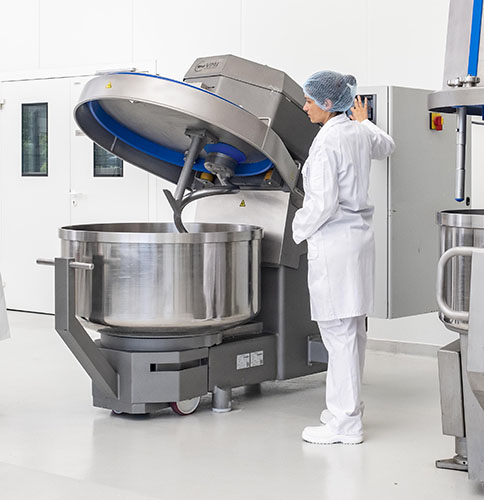
Cookies speak the universal language of taking a moment for a delicious treat, anytime, anywhere. The stakes are high to produce the next favorite creation; but, technology provides different mixing methods to guarantee a perfect start.
The first step that can make (or break) a great cookie is mixing. When making cookies from scratch, the order of incorporating ingredients plays a crucial role in achieving the desired texture. Generally, the fats go first – usually butter – together with the sugar. The liquid ingredients then join the mix, including eggs, with the powder ingredients (flour) being the last to be added. The challenge lies in managing adjustments to this order and the temperature of the fats used. French mixing specialist VMI recommends using softened butter, and avoiding fats that could be too hard. “If the butter is too firm, you will need a longer mixing time to achieve the right consistency,” VMI explains. To control the texture, preventing the gluten network development makes cookies softer; in this case, “Avoid overhydrating the flour and do not overmix the dough,” recommends the mixing expert.
However, an optimal approach cannot be set in stone, because best practices will vary significantly according to each cookie recipe. Finding the right balance is where the challenge lies.

Option #1: batch mixing cookie dough
Batch mixing is particularly beneficial when there are frequent recipe changes, when flexibility is required, and when running smaller production volumes. It accommodates different production capacities and recipes effectively. When using batch mixing technologies, there are several factors that can enhance the mixing process:
+ Choosing the right mixing tool
Selecting an appropriate mixing tool is essential: a paddle/beater with discontinuous flats or twisted paddle/beater is often ideal, VMI recommends, as it promotes better circulation of the dough within the bowl. This ensures effective mixing, even distribution of inclusions, and the ability to break down and incorporate fat blocks evenly. Alternatively, using regular spirals can be another efficient mixing option that gives good results.
+ The number of tools
Using a double-tool mixer can improve efficiency and speed up the mixing process.
+ Speed control
Adjusting the mixing speed is crucial for optimizing the process. A mixer offering speed variation can help by making more precise adjustments.
”It’s best to evaluate the specific product, recipe, and mixer to determine the exact equipment size needed for the required production volume.“
VMI specialists
Taking into consideration all of these factors for each recipe and specific production scenario, will considerably improve the efficiency of the mixing process for cookie dough. To determine the optimum batch size for the equipment and optimize energy consumption while using a batch mixer, a multi-angle approach is the answer: “It’s best to evaluate the specific product, recipe, and mixer to determine the exact equipment size needed for the required production volume,” VMI explains. Usually, the batch size that can be processed with the same equipment typically ranges between 30% and 100% of the machine’s nominal capacity. The specialist illustrates: “For example, with one of our spiral mixers with a 400 L bowl, batches as small as 80 kg can be processed, and as large as 250 kg, depending on the dough’s density, consistency, hydration, ingredients, etc.”

Option #2: continuous mixing cookie dough
Continuous mixing is synonymous with large-scale production. For this technique, efficiency and consistency are paramount. The corresponding technology, continuous mixers, are usually fully automated, ensuring that quality is maintained consistently throughout the process, from dosing to mixing. They are the most efficient for processes with few changes in recipes. Furthermore, these mixers offer great control over dough temperature, which can help to reliably achieve the desired texture and consistency in industrial cookie production.
However, using continuous mixers for cookies involves navigating some key differences compared to continuous mixing for baked goods like bread. One primary distinction is ingredient introduction, VMI notes: “Continuous mixers generally require a specific order: powders are added first, followed by liquids, to ensure proper pre-hydration before mixing in the main mixing chamber. In contrast, cookie production often involves a different sequence, where fats and inclusions need to be incorporated effectively at various stages of the process. The inclusion of mix-ins like chocolate chips requires careful management to ensure they are evenly distributed and remain intact, preserving the desired texture and appearance of the final product. For this reason, they will often be added later in the process.” The design of the continuous mixer and its dosing units must take these elements into account. The tool should also be suited for mixing unstructured doughs effectively.

Addressing all these unique requirements maximizes the efficiency and consistency that continuous mixers can offer for cookie production.
To navigate the differences and make the most out of both techniques, thorough recipe testing is a must, along with expert help with the technology. Mixing processes can be tailored to accommodate any variations needed, for best results.


